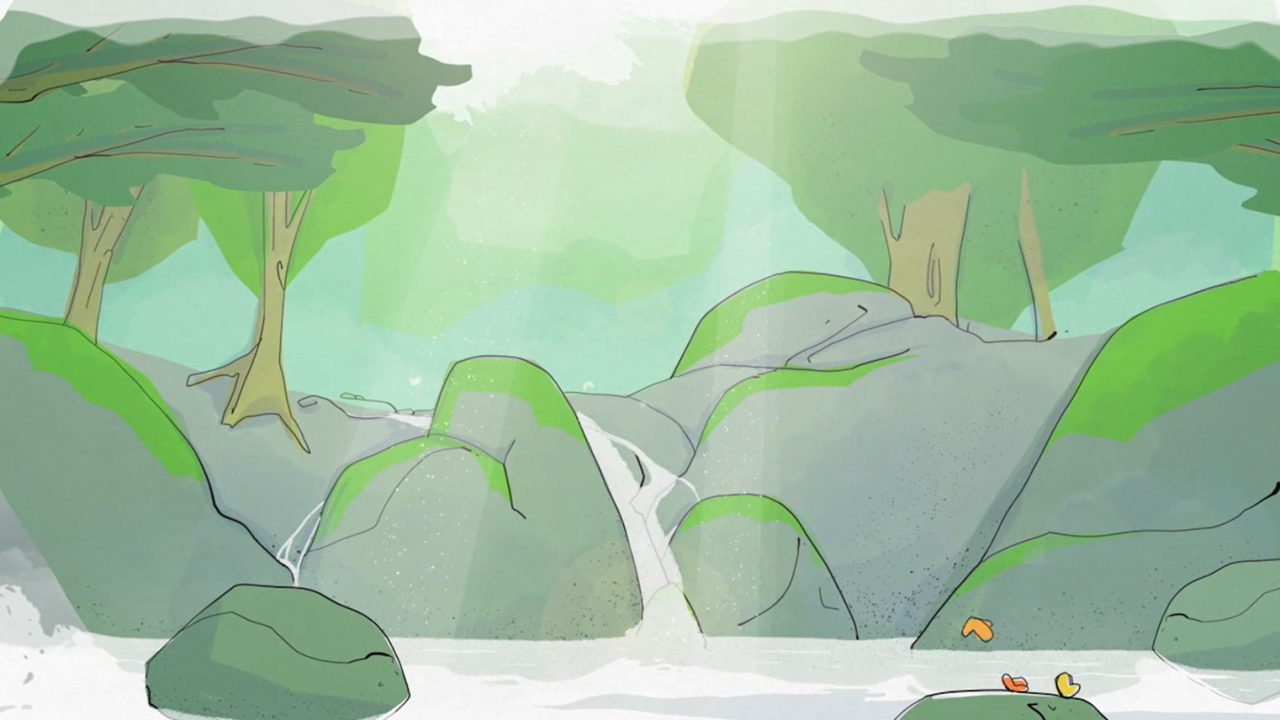
Mini-Lesson for The Big Reset – Worldviews
Mini-Lesson for The Big Reset – Worldviews
Mini-Lesson for The Big Reset – Worldviews
School Subjects: Citizen Responsibilities, Environmental Issues, Issues in Society Today, Life Systems/Ecology
Recommended Ages: 12–14
The Big Reset – Worldviews, Malcolm Sutherland, provided by the National Film Board of Canada
Keywords/Topics: Interconnection, Nature, Environment, Worldview, Relationship, Responsibility
Overarching Question: What is our place in the world?
Educational Synopsis: In the short film The Big Reset – Worldviews, geneticist and environmentalist David Suzuki asks us to look at our place in the world. He reminds us that we are just one part of a complex and awe-inspiring world and that our actions must change to reflect this worldview.
Activity 1: Identify the Main Ideas
The Big Reset – Worldviews, Malcolm Sutherland, provided by the National Film Board of Canada
Part 1: Show students this image that appears at the 17-second mark of the short film. Ask them to imagine themselves inhabiting the scene depicted in the image. Then give them two minutes to think about the following sensory questions:
- What do you see?
- What do you feel?
- What do you hear?
- What do you smell?
You may consider asking them to write down their answers, in which case, give them a template; for example, four thought bubbles, each containing one of the questions, displayed around the image.
After two minutes, ask them to share in pairs or threes.
Ask a few groups to share with the whole class.
Keep track of their comments that so that you can build a class response and refer to it in Part 3 of this activity.
Part 2: Now tell the students that this image is from the short film they’re going to be watching and studying today.
Ask them: What do you think is the main idea or topic of the short film? Ask them to justify their response by referring to their replies to the sensory questions. Capture the responses so that the whole class can see them and you can refer to them later.
Part 3: Let students know that you’ll be showing about 10 seconds from the short film and asking them if their thoughts on the main idea or topic of the short film have changed. Play the clip, with no audio, beginning with the image, from 0:17 to 0:26.
Ask them again: What do you think is the main idea or topic of the short film? Get a few initial responses and then play the film again to see if they can justify their response based on what they see. Capture these replies so that the whole class can see them and compare to their responses in Part 2.
Introduce the inquiry question for the lesson: “What is our place in the world?”
Let them know that today, as they watch the short film, they will be thinking about and trying to respond to the inquiry question.
Summary
This opening activity is meant to:
- frontload the main ideas of the short film using concepts that are transferable to other fields of study and to the life worlds of students beyond the classroom;
- elicit student prior knowledge and connections so that you can know what students are thinking, and so that they can form a foundation on which to engage with the rest of the lesson;
- allow you to make connections, as needed, to your subject of study.
Activity 2: Thinking Routine: See, Think, Wonder
The Big Reset – Worldviews, Malcolm Sutherland, provided by the National Film Board of Canada
Watch the whole short film with your students twice. Before watching it the first time:
- Give them a brief summary of the short film (for example, the educational synopsis) to support their understanding and engagement.
- Ask them to look up or provide the definition of any words that may be new, difficult or important to know (e.g., worldview, ecocentric, anthropocentric).
- Explain that they will be using a thinking routine called: I see… I think… I wonder… Only use I see… for the first viewing.
Now watch the short film, ask them to respond to the first part of the thinking routine (I see…), and capture their observations.
Options: You can have them do this verbally as a class, or ask them to individually write down their responses first and then share with a colleague, in order to develop their thinking and grasp that each person can have a different view. You can do the entire routine (I see… I think… I wonder…) in the first viewing and then support it with a second viewing.
Now watch it a second time. They can add more responses to I see… and then move to I think… by sharing what they think is happening or what they think about the observations they made. As they move to I wonder… you are encouraging students to wonder about what they observed, about their responses in Activity 1 (the main topic), and finally about the inquiry question, “What is our place in the world?”
Summary
The thinking routine is meant to support students in making thoughtful observations as well as support their response to the lesson inquiry. It also complements what Dr. Suzuki is asking of us and our youth to do in changing our worldview and seeing nature as a place of wonder, beauty, and discovery that should elicit gratitude and humility.
Activity 3: Quick-Write: A New Point of View
The Big Reset – Worldviews, Malcolm Sutherland, provided by the National Film Board of Canada
At the start of the short film, David Suzuki says, “I believe we have to shift the way we see our place in the world.” Ask students what they think Suzuki means by this statement.
Near the end of the film, he explains this idea further. Re-watch from the 2:00-second mark until the end and ask them to add to their responses based on what he is saying. They can also add from other parts of the film.
In a class or small-group discussion, encourage them to make connections and add responses based on:
- other texts, topics or experiences you have had as a class;
- other texts, songs, films they have read, heard or seen;
- experiences in their own lives, including what they are currently living.
Now, tell your students that they will be doing a quick-write informed by this discussion. Show them the image from the film at 0:47 (bulldozing nature in the pupil of an eye) to stimulate their ideas.
Ask them to do two quick-writes about what is happening in the image:
- one from an anthropocentric point of view (explain to younger students that this means from the point of view of a person);
- one from an ecocentric point of view (explain to younger students that they can choose something in the image or something related to nature, e.g., the trees, the air, the earth, the bird, the mountain).
Each quick-write can be between 15 to 50 words. You can decide the word count based on the amount of time you have, the age of your students and their writing ability. It would be helpful for you to model this for your students by sharing an example of each point of view.
Summary
Students can compare what they’ve written to explore whether the different points of view led to different responses. Explain that similar to the goal of this activity, David Suzuki is encouraging us to see the world through new eyes, using a different worldview; one in which we are not the most important factor and we fit in harmoniously with all of nature.
To wrap up the lesson, you can ask students to add to their response to the lesson inquiry question, “What is our place in the world?”, based on their exploration of the video and their own experiences during these activities.
Take Action: Multimedia Expression
Ask your students to creatively express their response to the lesson inquiry question, “What is our place in the world?”, through at least two mediums. For example, they could:
- draw or paint and include key words from the film in a visual project;
- create a collage or series of images and add a soundtrack;
- write a spoken-word poem and add stills (images) from the film (or similar);
- create an infographic poster.
All these projects could be done both in person or online. You can choose another option that reflects the method of learning and assessment you prefer or would like to work on with your students.
If students need some ideas, you can review with them what David Suzuki says beginning at the 2:00-minute mark in the film: about our interconnection, the need to re-discover ancient knowledge, to discover and celebrate our place within all of creation. You can ask students to research how First Nations, Inuit and Métis peoples relate to the natural world. They can find songs, images, texts from other traditions that also highlight our interconnection with and responsibility to the natural world.
Asif-Aly Penwala is an experienced secondary teacher and mentor with a double master’s degree from the University of London’s Institute of Education. He has taught and worked with teachers across Canada and in countries such as France, Madagascar, the United States, England and Tajikistan. He has also worked in community development with immigrants and refugees.
Pour lire cet article en français, cliquez ici.
Discover more Mini-Lessons | Watch educational films on NFB Education | Watch educational playlists on NFB Education | Follow NFB Education on Facebook | Follow NFB Education on Pinterest | Subscribe to the NFB Education Newsletter



